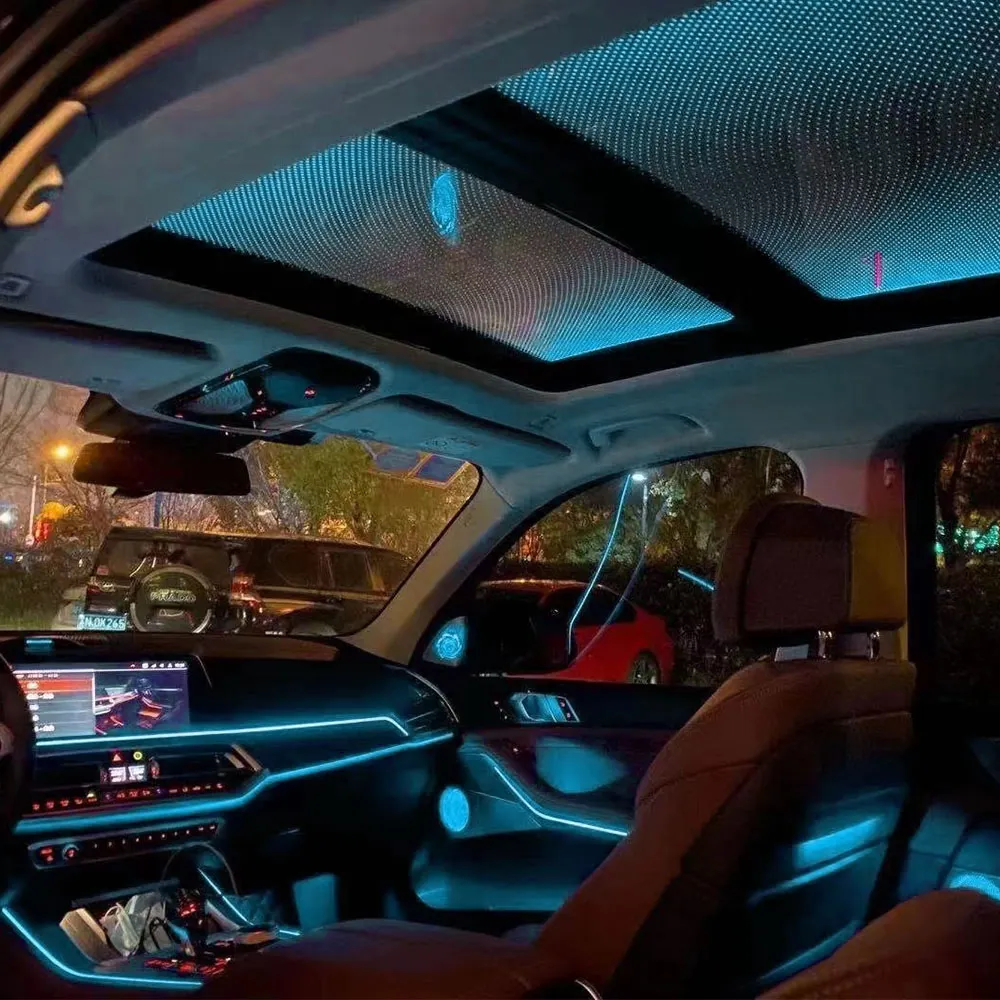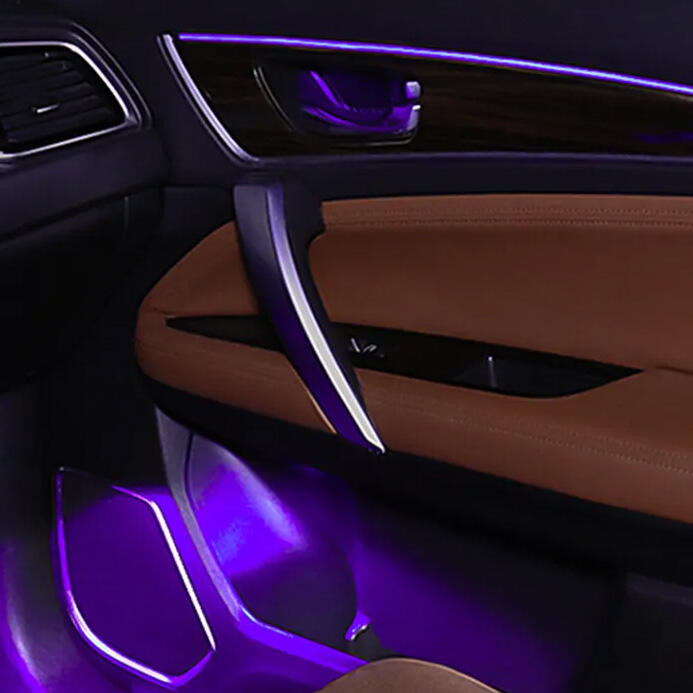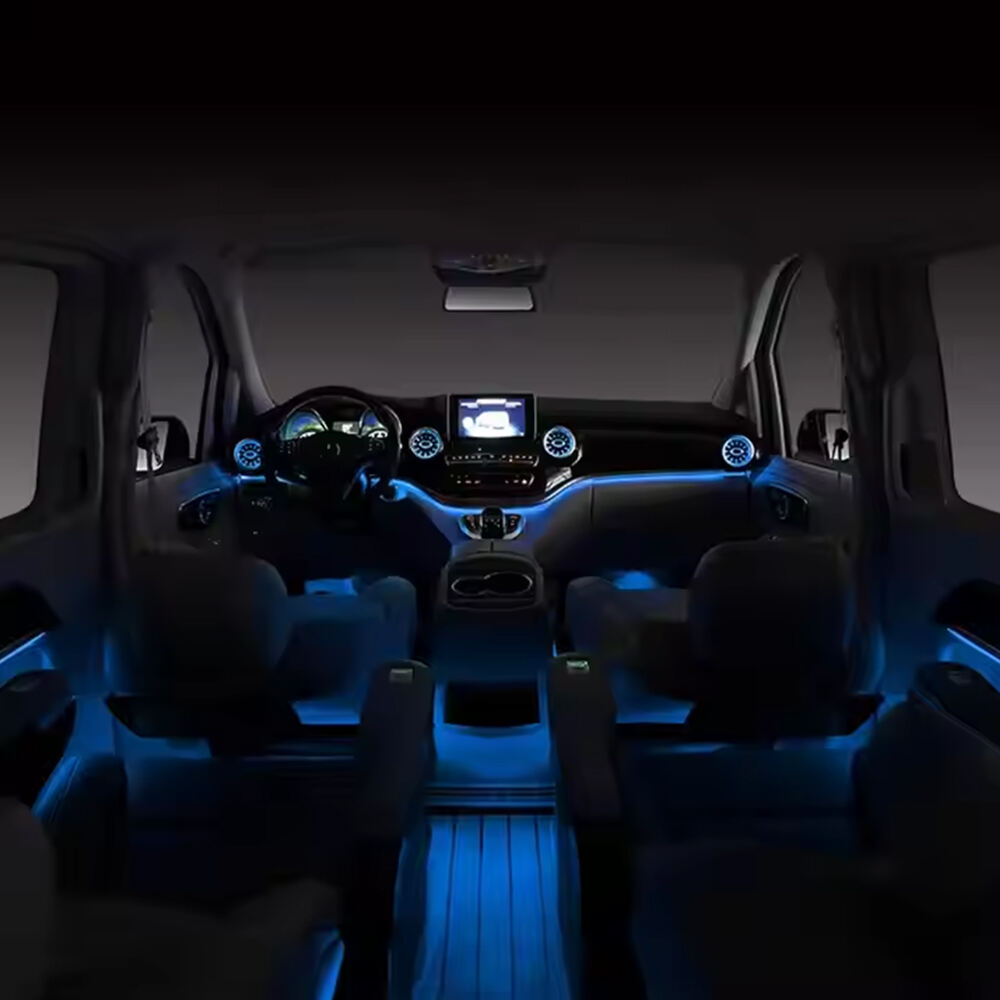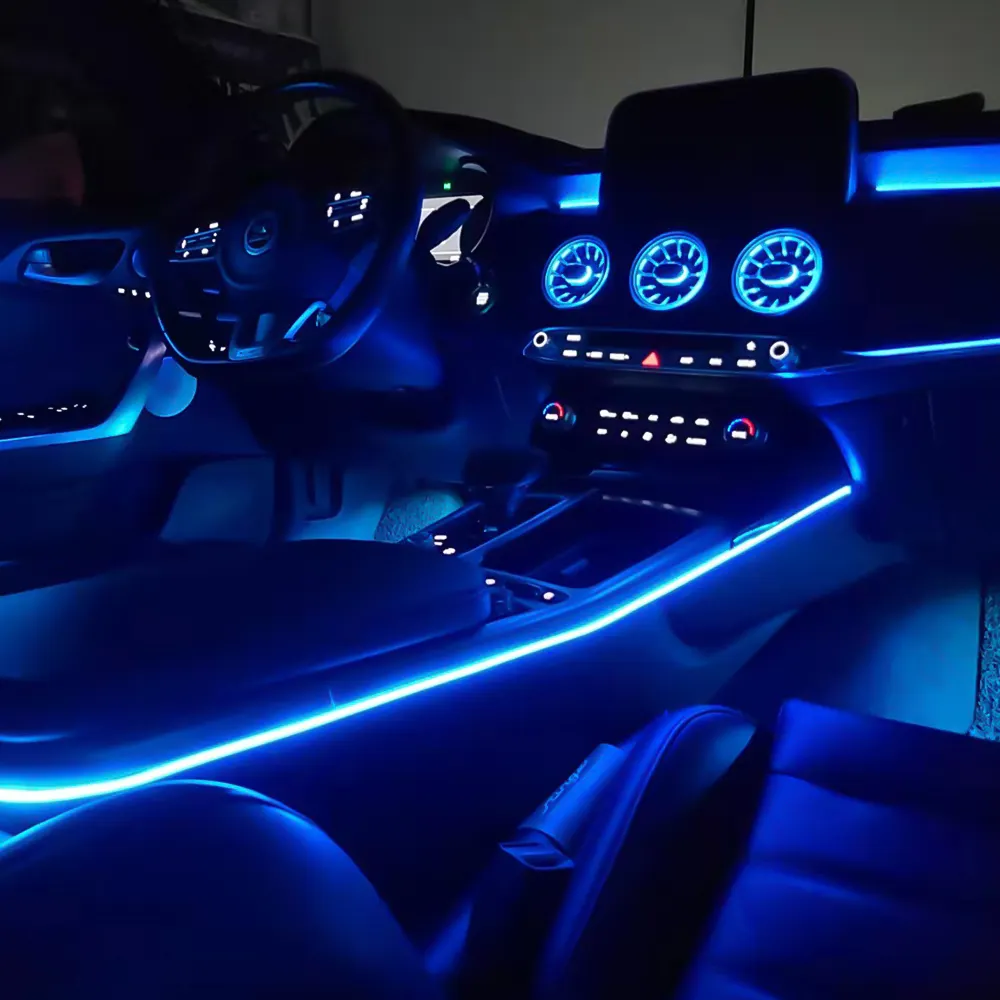The Design Philosophy Behind Sensory Harmony in Mercedes-Benz Interiors
Aligning luxury audio and lighting within Mercedes-Benz’s interior design language
Mercedes really steps up the game inside their cars by combining sound systems and lighting in ways that feel completely connected. Their Burmester 3D audio works hand in hand with changing lights across the cabin. The speakers are hidden right in the doors and ceiling so they don't stick out at all, and there are these thin fiber optic lines running along the edges of the interior that follow the car's shape perfectly. This attention to detail shows how serious Mercedes is about creating an experience for all the senses. Everything looks clean and simple but still feels very real and substantial. According to some research from last year, around three quarters of people who buy luxury vehicles care a lot about how everything inside the car feels together as a whole package. Mercedes definitely hits this mark with their carefully timed lighting changes and super accurate sound quality throughout the cabin.
Burmester 3D as an architectural element: Blending sound systems with aesthetic elegance
The Burmester 3D sound system with its 31 speakers does more than just play music; it's basically an art piece in itself. The aluminum covers on these speakers match up nicely with those shiny metal bits around the air vents throughout the car. What's really clever though is how they designed the resonance chambers inside the door armrests so they actually serve a dual purpose as structural support too. Mercedes designers didn't go the route of those aftermarket systems that stick out like sore thumbs and mess with the clean look of the cabin. Instead, they thought of each speaker as part of the overall sculpture of the vehicle. Take for instance the floating center speaker in the EQS sedan model, where it blends seamlessly into the backlit trim made with laser cutting technology. According to some recent studies looking at luxury cars from 2024, this design choice cuts down on visual clutter by about forty percent when compared to what we typically see in high end audio setups.
Benchmark: How premium automakers integrate audio brands like Burmester for cohesive luxury
Most car makers just slap their fancy sound systems into existing dashboards as an afterthought, but Mercedes does things differently. They actually develop Burmester components right from the start, working them into the design along with all those luxurious lighting features and interior details. Take the new S-Class for example. The overhead speakers are positioned so they line up perfectly with the ambient lighting channels, creating these amazing "sound-light columns" that simply can't be replicated when someone tries to install everything later. A recent J.D. Power study showed something interesting too. Mercedes came out on top when it comes to how well everything fits together in ultra-luxury sedans. Owners reported being much happier than folks with BMW's Bowers & Wilkins system, beating them by about 22%. And this approach makes sense really. When tech is designed into the car from day one rather than tacked on later, it just feels better. The whole experience remains seamless and luxurious, not some jarring addition that breaks the magic.
Immersive 3D Sound and Ambient Lighting: A Multi-Sensory Experience
How Burmester 3D Creates Spatial Depth That Complements Dynamic Ambient Lighting
Burmester's 3D audio system features around 31 speakers positioned throughout the car to create sound environments that match the actual space inside Mercedes-Benz vehicles. The way this audio system works goes hand in hand with changing light settings across different parts of the cabin, making for an overall immersive feel when driving. With detailed sound mapping technology, lower sounds tend to come from areas close to the floor where lights are also located, whereas higher pitched sounds seem to bounce off the upper parts of doors that have their own illumination. What happens next is pretty amazing really. Instead of just listening to music, passengers actually experience it physically because the lights pulse along with beats and rhythms, adding another layer to how we perceive sound in these luxury cars.
Synchronizing Mood-Based Stimuli: Audio Immersion Meets Color Psychology in Lighting
Benz has teamed up with Burmester to create sound experiences that match specific lighting colors throughout the car interior. When someone puts on some mellow jazz or classical music, the lights inside warm up to around 2700K to 3500K range, which research suggests helps people feel more relaxed. The amber tones seem to calm folks down according to those color psychology experiments we keep hearing about. On the flip side, when drivers crank up their favorite electronic beats, the dashboard turns blueish cool, helping them stay alert while pushing through traffic. According to a recent study from Automotive UX Report 2023, almost four out of five drivers say they feel more connected emotionally when these features work together. The MBUX system does something pretty neat too – it changes both the music volume and brightness at once. So during that big orchestral swell moment in Beethoven's Fifth Symphony? The whole dashboard lights up like waves crashing against rocks.
The Rise of Multi-Sensory Convergence in High-End Automotive Cabins
The way luxury car manufacturers design interiors has changed dramatically in recent years. Instead of just focusing on comfort, they're creating full sensory experiences inside the cabin. Take Burmester's 3D audio system paired with ambient lighting controlled by a single processor that cuts down lag time to around 15 milliseconds or less for smooth coordination. According to market research from last year, nearly two thirds of people buying high end vehicles care more about these immersive features than straight power numbers. Looking ahead, some concept cars already show what's coming next. Prototypes have speakers built into seats that actually vibrate along with deep bass notes while footwell lights pulse rhythmically, making it hard to tell where touch ends and sound begins. These innovations are redefining what we expect from our driving experience.
Key Innovation:
| Feature | Burmester 3D | Industry Average |
|---|---|---|
| Speaker Channels | 31 | 16–20 |
| Audio-Light Sync Speed | 15ms | 50–75ms |
| Color Palette Options | 64 adaptive hues | 12 static colors |
Personalized Sound Light Profiles Through MBUX Integration
Customizing Burmester Soundscapes Alongside 64-Color Ambient Lighting Themes
The MBUX interface from Mercedes-Benz lets drivers customize two things at once by linking their Burmester 3D audio settings to one of 64 different ambient lighting colors. People love matching these rich sound experiences - think the grand "Concert Hall" setting or the all-encompassing "Surround" mode - with specific color schemes. Indigo tones work great during long highway trips while bright reds really pop when someone wants to drive with energy. What makes this setup special is how it automatically changes both the music quality and lights depending on which driving mode is selected. But don't worry, there are ways to manually tweak everything if someone prefers complete control over their own unique combination.
Using MBUX to Synchronize Audio Dynamics with Lighting Intensity and Color Shifts
Using voice commands with these smart recognition systems makes it really easy to control both sound and light effects together. When someone says "relaxation mode," the Burmester speakers adjust their high-end sounds and the ambient lights change to those warm gold colors around 4500K temperature. The car gets interesting when accelerating too. The system kicks up the mid-bass by about 6 decibels and starts flashing the dashboard lights along with whatever beats are detected in the music. This creates a more engaging driving experience but still keeps things safe since drivers aren't getting distracted.
User-Centric Design: Saving Driver Preferences for Combined Audio-Light Moods
Up to seven personalized profiles store settings for recurring scenarios:
- Commute Mode: Balanced sound signature with circadian-adjusted cool white lighting (4800K)
- Date Night: Jazz playlist acoustics paired with discreet rose-gold accents
- After-Sport Recovery: Noise-cancelled cabin with massaging-seat synced amber waves
MBUX’s machine learning adapts over 3,000+ miles of use, proactively suggesting new audio-light pairings while preserving driver control through its “Adaptation Threshold” slider.
Technical Synergy: How Burmester 3D and Ambient Lighting Are Engineered to Work Together
Behind the Scenes: Acoustic Mapping Aligned with Ambient Light Zones in S-Class and EQS
Burmester 3D audio gets some serious fine tuning from Mercedes-Benz engineers who match speaker positions to different lighting areas throughout vehicles such as the S-Class and EQS models. What happens is pretty cool actually the system connects those 31 speakers to specific shapes that follow how the interior lights are arranged, so the music comes out from basically the same spots where the car's lights shine. The result feels like sitting inside this amazing audio-visual bubble. When someone looks at their dashboard, they hear high notes coming from right there next to those indicator lights. And when they glance down at their feet, bass sounds match up perfectly with the LED strips below the doors, making it feel like sound wraps around them naturally instead of just coming from somewhere behind.
Data Point: 31-Channel Burmester 3D Audio and 64-Color Lighting Integration in EQS Models
The 2024 EQS sedan takes integration to another level altogether. Inside, there's this amazing 31-channel Burmester 3D sound system that works hand in hand with those 64 different color options for ambient lighting throughout the car. When playing high quality music tracks, the lights dance across the door panels and center console in beautiful gradient patterns. Even better? The navigation system gets involved too, lighting up specific areas when giving directions or alerts. Want something relaxing during a long drive? The system switches to cool blue tones on highways. Need to stay alert in busy city traffic? Warm amber colors take over instead. All these changes happen automatically based on what kind of music is playing, turning the whole interior space into something almost magical for drivers who appreciate both tech and atmosphere.
Software Driven Synchronization: Matching Audio Transients with Light Animations
The system has this special middleware component that handles Burmester's 3D audio signals at an impressive 24-bit/96kHz resolution for those real time light shows. When bass drops below 60Hz, it creates these sweeping patterns across the overhead console area. The midrange vocals between about 300Hz to 3kHz? Those tend to highlight the touch controls with accent lighting. And through MBUX over the air updates, users can install all sorts of themed sound-light combinations. Think classical music pieces matched with gradually dimming golden lights, or electronic beats that sync perfectly with flashing RGB effects throughout the cabin. Pretty cool stuff when it all comes together right.
Elevating Luxury Perception Through Coordinated Sensory Design
How Synchronized Sound and Light Enhance Perceived Quality and Exclusivity
When Burmester 3D audio meets ambient lighting, something special happens that changes how we think about luxury altogether. Research from Frontiers in Communication back in 2024 showed these combined experiences actually boost perceived value by around 41% over just having one fancy feature alone. What makes this system so impressive? Well, it's got 31 channels spreading sound throughout space while matching up with changing lights. Imagine sitting there feeling deep bass thumps that match exactly with colors shifting across the room. This kind of coordination taps into different aspects of what makes something feel luxurious touch feels richer, visuals look more sophisticated, and people actually start connecting emotionally with their surroundings through these carefully designed combinations of light and sound.
Future Trends: Holistic Sensory Branding in Premium Automotive Experiences
Car manufacturers are starting to bring in ideas from brain science when designing cars that appeal to all our senses. According to research published last year, car brands that mix sounds, looks, and touch experiences get around three times better scores for feeling exclusive compared to companies that just focus on what their cars are made of. We can expect future vehicles to include things like smell dispensers and seats that give physical feedback along with the already impressive lighting systems from Burmester. These changes create complete sensory experiences inside the car cabin that respond to how drivers feel physically. For luxury car makers especially, getting these different senses working together seems to be becoming standard practice instead of something special.
FAQ
What is the main feature of the Burmester 3D sound system in Mercedes-Benz vehicles?
The Burmester 3D sound system integrates 31 speakers that are strategically positioned throughout the car, providing an immersive audio experience that complements the vehicle's spatial design.
How does lighting enhance the driving experience in Mercedes-Benz cars?
Mercedes-Benz pairs ambient lighting with audio to create coordinated sensory experiences. Changing lighting colors in combination with the Burmester sound system enhances mood and complements music genres for a seamless, luxurious experience.
What is the role of MBUX in customizing audio and lighting?
The MBUX interface allows for personalization of soundscapes and ambient lighting themes. Drivers can sync audio settings with different lighting modes, automate them for various driving scenarios, or manually adjust them for a tailored sensory experience.
How are future automotive sensory designs expected to evolve?
Future designs are expected to incorporate holistic sensory experiences beyond audio and lighting, including smell and tactile feedback, enhancing luxury branding and perceived exclusivity through coordinated sensory elements.






